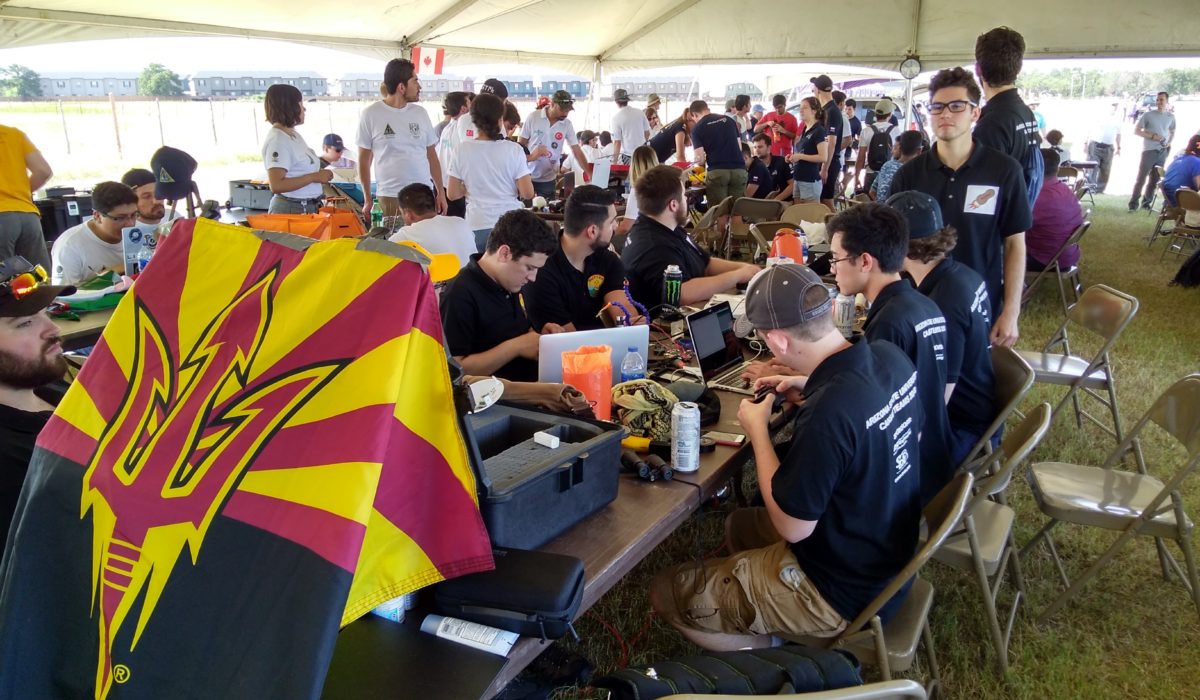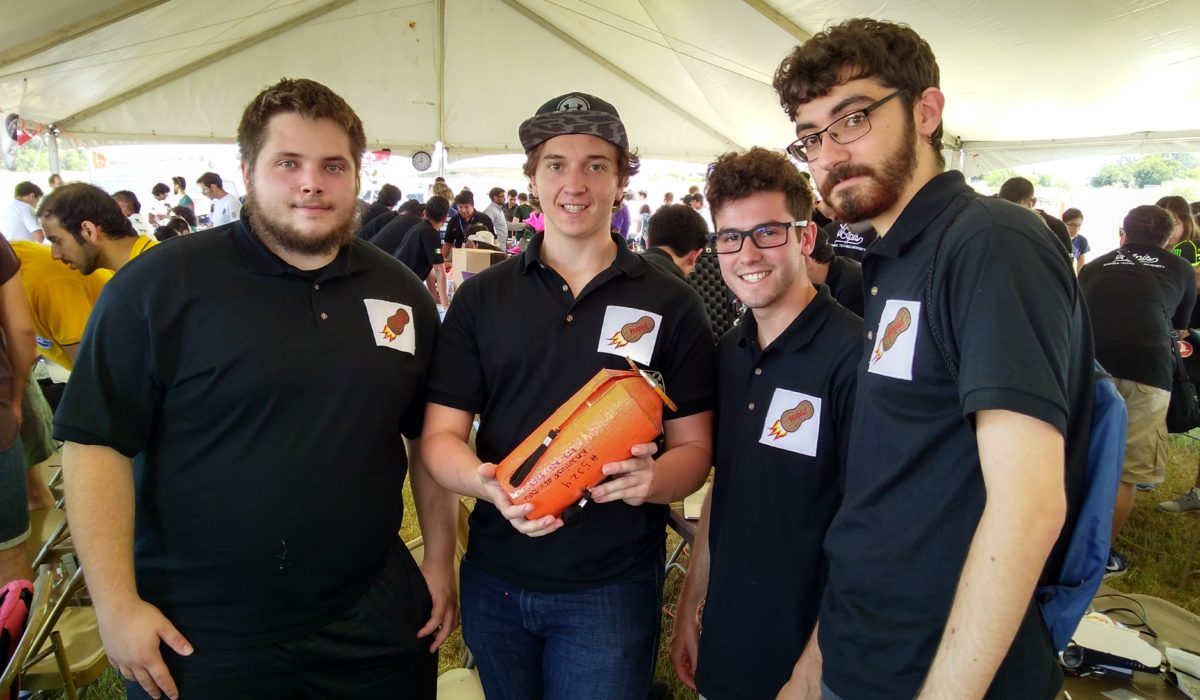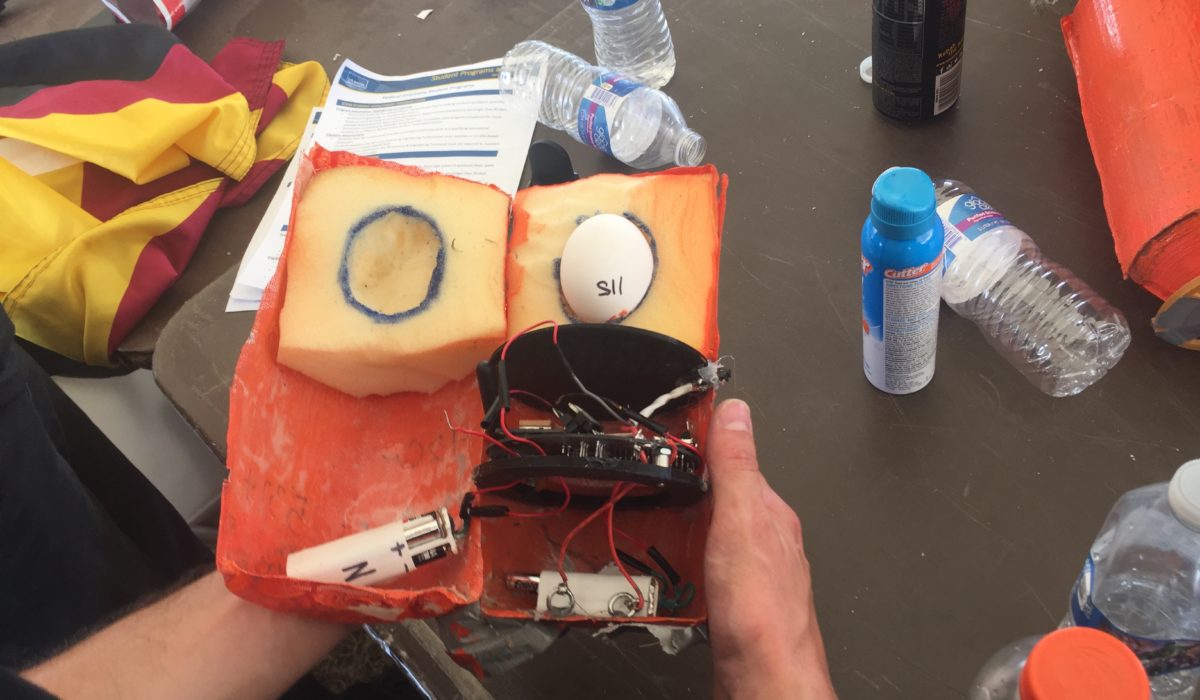
Egg-spect the unexpected: ASU students test their skills at CanSat competition
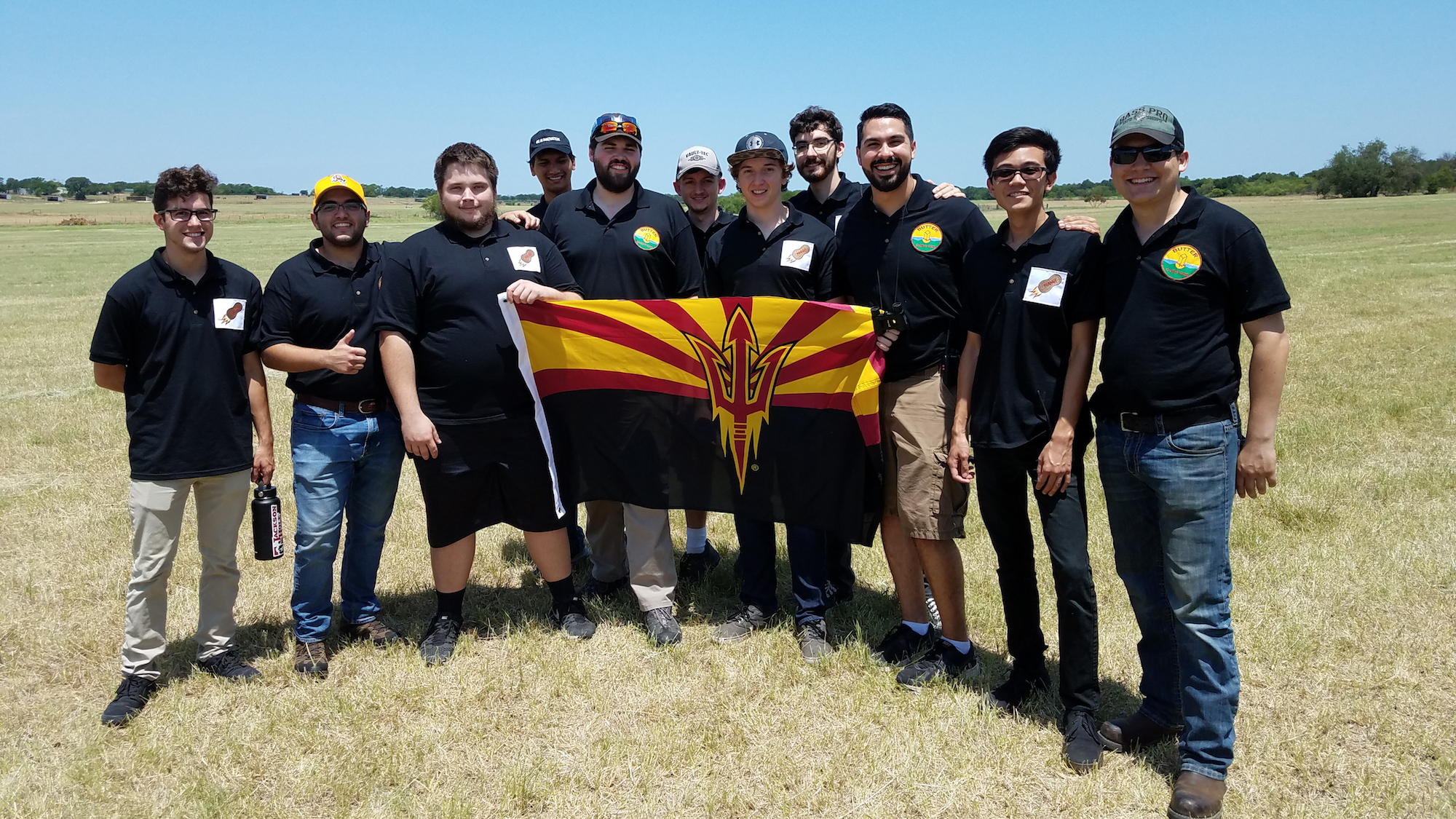
A rocket releases a bright orange probe high in the air above a patchwork field. A team on the ground establishes communication with the rocket as it reaches nearly 2,300 feet. After 39 seconds the probe, deploys its heat shield and begins its descent. So far, so good.
Amid intense vibrations as it hurtles through the atmosphere, the probe’s parachute deploys early, causing the heat shield to separate early. It’s unbalanced and spinning swiftly toward the ground — but it collects the necessary data and lands intact on a grassy field.
The ground control team, led by Arizona State University student Anthony McCourt, retrieves the probe and checks for damage. The cargo — a raw chicken egg — is intact.
The egg represents a delicate precision instrument in a cargo space the size of a soda can aboard a satellite — a “CanSat.” These can satellites are equipped with temperature and air pressure sensors for measuring the atmosphere, a communication system to transmit information back to ground control and a parachute to help land safely. Each year, this cargo is stored in a different, aerospace-based container, including helicopters, gliders and descent probes.
At the American Astronautical Society CanSat competition in June 2018, teams of students from around the world gathered in Stephenville, Texas — including two teams of ASU students from the Ira A. Fulton Schools of Engineering — to exhibit their CanSat’s ability to deliver an egg safely to the ground.
ASU’s Team BUTTER (Ballistic Universal Times Trajectory Egg Recovery) took home fifth place, and Team PEANUT (Protective Egg Assembly Negating Unimaginable Traumas) earned 10th place out of 33 teams.
The AAS CanSat competition is a design-build-launch challenge that tasks students with working on the full spectrum of a complex engineering project — including developing a concept, integrating the design into a physical device, testing, operation and a post-mission debrief.
Months of effort came down to an emotional and exhilarating three-minute test as their probe is launched and lands as expected — or not as expected, as Team PEANUT leader Kevin Julius experienced.
The longest three minutes ever for Team PEANUT
Before their turn to compete, Julius saw the light on the CanSat wasn’t flashing like it was supposed to after pulling the activation pin. Maybe the two hours it spent in a hot van was to blame. Light or no light, it was time for Team PEANUT to boot up the ground control station and prepare for launch.
But then the laptop began to overheat in the Texas heat, and communication from the CanSat fizzled out. Still, working or not, it was launch time.
The rocket ascended. The CanSat remained silent and off.
As the rocket reached its final height and ejected the CanSat, ground control began receiving communications. A moment of relief. The probe went through the motions of deploying the heat shield, relaying these actions to ground control. However, as Team PEANUT’s members watched from the ground, they saw their orange CanSat — without its heat shield — speeding toward them much too quickly.
It thudded to the ground right in front of them. There was still hope for success if their egg had survived. Their apprehension turned to excitement as they discovered an intact egg inside.
The heat had led to a structural failure inside the probe and to an undeployed heat shield and parachute. However, because they achieved the objective of protecting the egg — even at triple the expected velocity — Julius’ Team PEANUT had missed only the competition’s deployment requirement and ended up with a 10th place finish.
A holistic design challenge
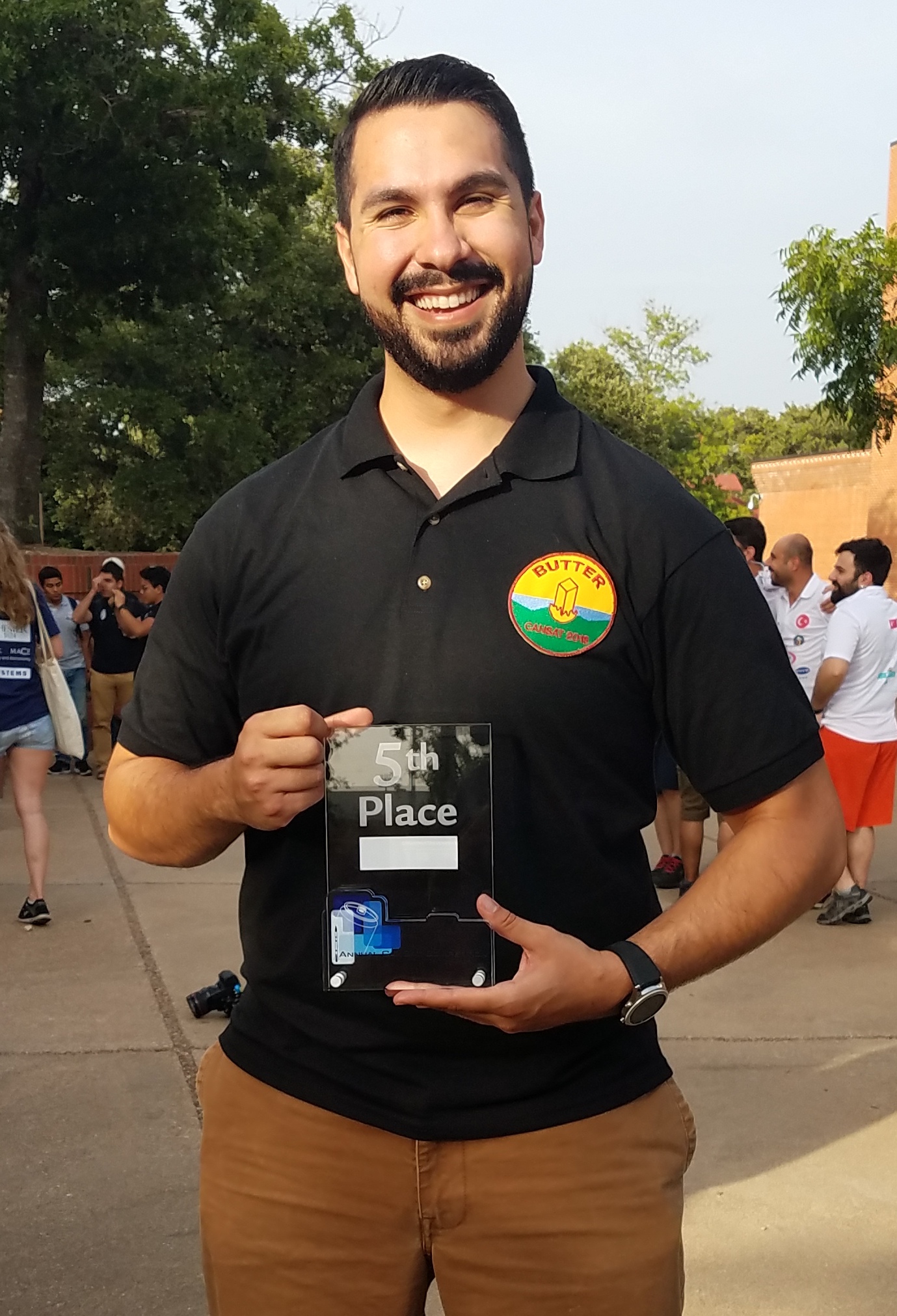
Anthony McCourt poses with the Team BUTTER’s fifth place award. Photo courtesy of Anthony McCourt
For the competition, students designed CanSat probes to safely carry an egg through all stages of flight – from launch to entering the atmosphere to landing. Student teams were required to design their CanSat on a budget and on a schedule, participate in design reviews and complete the launch. The AAS provided rockets that took the eggs up 700 meters in elevation, or approximately 2,300 feet.
Team BUTTER leader Anthony McCourt says the CanSat competition differs from other proposal-type competitions he has participated in that it requires more than just a research and methods-writing challenge.
“CanSat provides this investigation and proposal portion of the engineering design process, but allows us to follow through and physically design, test and fly the thing we had been writing about in just the span of a school year,” said McCourt, who will begin graduate studies in aerospace engineering in the fall. He participated in the 2018 CanSat competition as a senior – his third competition in the past three years.
Students also get to put their project management, budgeting, team organization and critical objective skills to the test, said Julius, who will be a mechanical engineering junior in the fall.
Sun Devil Satellite Lab offers CanSat competitors an advantage
Participants from both ASU teams are part of the Sun Devil Satellite Laboratory, a student organization for those interested in the universe, spacecraft and engineering. Guided by the Fulton Schools and the ASU School of Earth and Space Exploration.
Students employ multidisciplinary skills in designing and developing satellites and satellite-related technology.
SDSL students have participated in the AAS CanSat competition since 2014. In 2017, Team JELLY (Joint Engineers for Light-weight Light-powered flYers) earned third place, ASU’s best showing in the CanSat competition.
For the 2018 competition, more SDSL students were interested in the competition than in previous years, so they entered two teams. Each team is made up of sub-teams focused on areas such as the aerodynamics, mechanics, electronics and communications of the CanSat.
Participants’ classroom knowledge of aerodynamic theories, MATLAB coding, SolidWorks computer-aided design modeling, circuit integration and design, and computer programming helped them develop a successful design. The rest of what they needed to know they picked up through competition experience and working with more experienced students.
“Our computer science team learned a lot from other programmers and the electrical team learned a lot from older peers who had worked on circuit design and integration before. On the mechanical and aerospace side, we had to learn and experience working with fiberglass and epoxies in order to bring our computer-aided design models to life and make them work,” said McCourt, who graduated from the Barrett, The Honors College in spring 2018.
Beyond technical skills, Julius emphasized the importance of communication to team success rather than focusing on engineering work within individual sub-teams.
Being part of SDSL helped the teams with costs associated with building their CanSats — and learning to budget the funds they had to raise — and with manufacturing resources and brainpower, including advice they received from the organization’s alumni network. Former competitors shared their knowledge of past mistakes in CanSat competitions with new team members.
McCourt has found all of these aspects of the competition and other SDSL activities rewarding.
“SDSL has given me so many great experiences throughout my undergraduate career,” McCourt said. “Working with them has given me a larger network of peers who have been able to help me in school and in the search for employment. Also, I have gotten to learn many skills with manufacturing and with rocketry that I would not have gotten with just attending classes. I would recommend SDSL for any student looking to get involved in space technology or who is interested in getting a hands-on experience that they yearn for outside of the classroom.”
Julius will continue to participate in CanSat competitions with SDSL students next year, but as an engineer rather than a team leader so that he has time to focus on other projects as well. He encourages other students to get involved in SDSL and take advantage of the full range of opportunities it affords.
“SDSL has different projects that have positions for different engineering majors that anybody could find good experience doing,” Julius said.
Meet the teams
Student org reaches for the stars
In addition to CanSat competitions, the Sun Devil Satellite Lab student organization’s members recently competed in the Blue Origins Pitching Competition with a proposal of a CubeSat (a cube-shaped satellite) called ThunderBIRD.
Students also work on ongoing NASA-related research projects. In collaboration with NASA’s Jet Propulsion Laboratory, they’re researching pulsed plasma thruster technology, which they test in the organization’s vacuum chamber.
As part of the NASA Undergraduate Student Instrument Project organized by the NASA Wallops and Goddard Facilities, students are also developing Phoenix, a cube satellite that will study the urban heat island effect in U.S. cities. The Phoenix satellite is scheduled to be ready for the International Space Station’s December 2018–January 2019 launch window.
Still, SDSL members can’t get enough of satellite and space technology-related projects, so they’re seeking more opportunities to flex their skills.
“SDSL is always looking for more projects and proposals to get involved with as well as providing more professional resources for members involved in any of the SDSL project,” McCourt said.
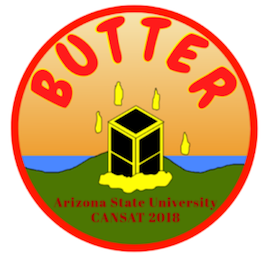
Team BUTTER
Team lead: Anthony McCourt, aerospace engineering senior
Aerospace subsystem lead: Matthew Meiers, aerospace engineering (astronautics) junior
Aerospace engineer: Frankie Pinon, aerospace engineering (astronautics) junior
Mechanical subsystem lead: Lyle Hailey, mechanical engineering graduate student
Aerospace engineer: Mennatallah Hussein, aerospace engineering (aeronautics) sophomore
Aerospace engineer: David “Jack” Madden, aerospace engineering (astronautics) freshman
Electrical engineering/computer science subsystem lead: Mecah Levy, electrical engineering sophomore (alternate team lead)
Robotics engineer: Michael Campbell, engineering (robotics) junior
Computer science engineer: Sina Malek, computer systems engineering junior
Computer science engineer: Vijay Ramakrishna, computer science (software engineering) junior
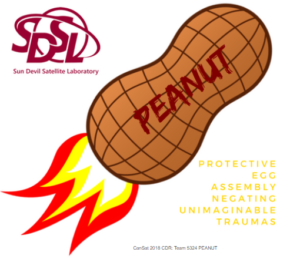
Team PEANUT
Team Lead: Kevin Julius, mechanical engineering sophomore
Aerospace Subsystem Lead: Marko Green, aerospace engineering (astronautics) junior
Mechanical Subsystem Lead: John Wenig, mechanical engineering junior
Mechanical Engineer: Seth Palermo, mechanical engineering junior
Mechanical Engineer: Sajana Ratnayake, mechanical engineering junior
Programming Subsystem Lead: Stephen Flores, computer science junior
Electrical Subsystem Lead: Ieeshan Sharma, electrical engineering graduate student































